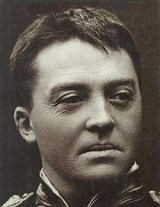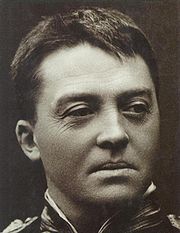
Smithy code
Encyclopedia
- This article refers to a cipher used in 2006 by Mr Justice Peter SmithPeter Smith (judge)Sir Peter Winston Smith , styled The Hon Mr Justice Peter Smith, is a Judge of the High Court of Justice in England and Wales, appointed to that office on 15 April 2002 and assigned to the Chancery Division...
and inserted into his judgment in the litigation concerning alleged plagiarism by Dan Brown. For the prisoner code invented by Capt. Smitty Harris in 1965, see Tap Code.
The Smithy code is series of letters embedded, as a private amusement,
within the April 2006 approved judgement of Mr Justice Peter Smith
Peter Smith (judge)
Sir Peter Winston Smith , styled The Hon Mr Justice Peter Smith, is a Judge of the High Court of Justice in England and Wales, appointed to that office on 15 April 2002 and assigned to the Chancery Division...
on the The Da Vinci Code
The Da Vinci Code
The Da Vinci Code is a 2003 mystery-detective novel written by Dan Brown. It follows symbologist Robert Langdon and Sophie Neveu as they investigate a murder in Paris's Louvre Museum and discover a battle between the Priory of Sion and Opus Dei over the possibility of Jesus having been married to...
copyright case. It was first broken by Dan Tench, a lawyer who writes on media issues for The Guardian
The Guardian
The Guardian, formerly known as The Manchester Guardian , is a British national daily newspaper in the Berliner format...
, after he received a series of email clues about it from Justice Smith.
How the code works
The letters in question are part of the actual text of the judgement, but italicised in contrast to the rest of the text. The following sequence of unusually italicised letters can be extracted from the judgement document:- s m i t h y c o d e J a e i e x t o s t g p s a c g r e a m q w f k a d p m q z v
The italicised letters only occur up to paragraph 43 (which is page 13 of a 71-page document). Meanwhile, paragraph 52 concludes with this sentence: "The key to solving the conundrum posed by this judgment is in reading HBHG and DVC." (These abbreviations are used by Smith throughout the judgement in referring to the books at issue, The Holy Blood and the Holy Grail
The Holy Blood and the Holy Grail
The Holy Blood and the Holy Grail is a book by Michael Baigent, Richard Leigh, and Henry Lincoln....
and The Da Vinci Code
The Da Vinci Code
The Da Vinci Code is a 2003 mystery-detective novel written by Dan Brown. It follows symbologist Robert Langdon and Sophie Neveu as they investigate a murder in Paris's Louvre Museum and discover a battle between the Priory of Sion and Opus Dei over the possibility of Jesus having been married to...
.)
There are 70 sections in the judgement. The source words from the judgement for the letters (with intervening words removed):
Claimants claimant is that his reality cynicism for preceeded templar
Jersey able research this techniques extinguished technical story was the something groups used was documents being eradicated elsewhere Templars Claimants sequence with of key Plantard introduced manuscripts ultimately questions emblazoned prevalent
Letter frequencies
Excluding leading letters "s m i t h y c o d e", the letter frequencies are as follows:- a - 4
- e - 3
- g, m, p, q, s, t - 2
- c, d, f, i, j, k, o, r, v, w, x, z - 1
Letter Location
Paragraph numbers for cipher letters:- 1 Claimant(s)
- 2 clai(m)ant
- 3 (i)s (t)hat ... (h)is ... realit(y)
- 4 (c)ynicism
- 5 f(o)r
- 6 prece(d)ed
- 7 T(e)mplar
- 8 New (J)ersey ... (a)ble
- 9 res(e)arch
- 11 th(i)s ... techniqu(e)s
- 13 e(x)tinguished
- 14 (t)echnical
- 16 st(o)ry ... wa(s)
- 18 (t)he
- 19 somethin(g)
- 20 grou(p)s
- 21 u(s)ed
- 23 w(a)s
- 25 do(c)uments ... bein(g) ... e(r)adicated
- 26 elsewh(e)re
- 27 Templ(a)rs
- 29 Clai(m)ants ... se(q)uence
- 30 (w)ith
- 31 o(f)
- 34 (k)ey
- 35 Plant(a)rd
- 37 intro(d)uced
- 38 manuscri(p)ts
- 40 ulti(m)ately
- 42 (q)uestions
- 43 embla(z)oned ... pre(v)alent
Hints
From article "'Da Vinci' judgement code puzzles lawyers":- The New York Times reported that Smith sent an e-mail to a reporter at the newspaper that offered a hint. It said the code referred to his entry in this year's edition of Britain's "Who's Who," which has references to his wife Diane, his three children Frazier, Parker, and Bailey, British naval officer Jackie Fisher, and the Titanic Historical Society - among other things.
Solution
The cipher was a type of polyalphabetic cipherPolyalphabetic cipher
A polyalphabetic cipher is any cipher based on substitution, using multiple substitution alphabets. The Vigenère cipher is probably the best-known example of a polyalphabetic cipher, though it is a simplified special case...
known as a Variant Beaufort, using a keyword based on the Fibonacci sequence
Fibonacci number
In mathematics, the Fibonacci numbers are the numbers in the following integer sequence:0,\;1,\;1,\;2,\;3,\;5,\;8,\;13,\;21,\;34,\;55,\;89,\;144,\; \ldots\; ....
, namely AAYCEHMU. This is the reverse of the Vigenère cipher
Vigenère cipher
The Vigenère cipher is a method of encrypting alphabetic text by using a series of different Caesar ciphers based on the letters of a keyword. It is a simple form of polyalphabetic substitution....
, which here enables decryption rather than encryption.

The 10th ciphertext letter, T, should really be an H, and there should also be a Z at the end of the ciphertext.
The repetition of the digraph 'MQ', after 8 letters, suggested a key that was 8 letters long, which is in fact the case. (This type of attack on a cipher is known as a Kasiski test
Kasiski examination
In cryptanalysis, Kasiski examination is a method of attacking polyalphabetic substitution ciphers, such as the Vigenère cipher...
).
The full plaintext should read:
JACKIEFISHERWHOAREYOUDREADNOUGHT, ("Jackie Fisher who are you? Dreadnought")
although correct application of the cipher in reverse, to decrypt, actually yields:
JACKIEFISTERWHOAREYOUDREADNOUGH
The algorithm for generating the plaintext from the ciphertext is: repeating the eight-letter key, add the relevant key letter to each plaintext letter, and then take a step one letter back.
(Alternatively, as is done in a professional context, the letters of the alphabet may be numbered from 0, in which case the final step back does not have to be made).
Jackie Fisher was a British admiral. "He was a driving force behind the development of the fast, all big-gun battleship, and chairman of the Committee on Designs which produced the outline design for the first modern battleship, HMS Dreadnought
HMS Dreadnought (1906)
HMS Dreadnought was a battleship of the British Royal Navy that revolutionised naval power. Her entry into service in 1906 represented such a marked advance in naval technology that her name came to be associated with an entire generation of battleships, the "dreadnoughts", as well as the class of...
."
Python
This Python implementation of the decryption algorithm produces the output "jackiefisterwhoareyoudreadnough".
ciphertext = 'jaeiextostgpsacgreamqwfkadpmqzv'
password = [1, 1, 25, 3, 5, 8, 13, 21]
def decrypt(n, c):
c = ord(c) - ord('a')
p = (c + password[n % len(password)] -1) % 26
return chr(ord('a') + p)
print( "".join( decrypt(n, c) for n, c in enumerate(ciphertext) ) )
Perl
An equivalent Perl 5 implementation:
use strict;
use warnings;
my @password = (1, 1, 25, 3, 5, 8, 13, 21);
sub decrypt_char {
my ($n, $c) = @_;
$c = ord($c) - ord('a');
my $p = ($c + $password[$n % scalar(@password)] -1) % 26;
return chr(ord('a') + $p);
}
sub decrypt_string {
my $s = shift;
my $n = 0;
return join } split);
}
The command print decrypt_string('jaeiextostgpsacgreamqwfkadpmqzv') produces output 'jackiefisterwhoareyoudreadnough'.
External links
- The complete text of the judgment was formerly available at http://www.hmcourts-service.gov.uk/images/judgment-files/baigent_v_rhg_0406.pdf.
- The archived copy of this text from 5 December 2006 can be found here, text of the judgment without the italics that mark out the cyphertext.
- Famous Unsolved Codes (lists the Smithy Code as solved)
- Kryptos Group report - analyzes how the code is put together, and contains a link to a mirrored copy of the PDF of the original judgment
- Tool to crack the code

